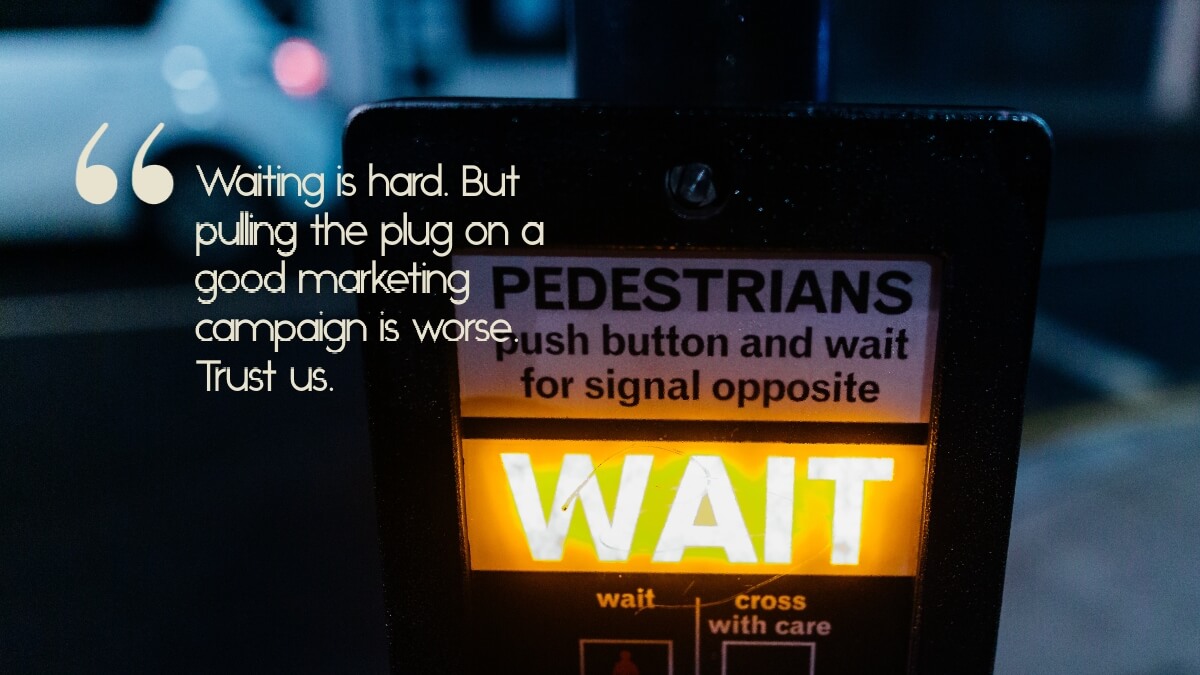How soon is too soon to call time of death on your marketing campaign?

The other day, a client of ours emailed us. He said that since the digital marketing campaign we had set up hadn’t produced any results yet, perhaps we should start brainstorming different approaches. Now, to be clear. in this case, it was way too early to be asking that question, since the ads had been running a couple of days at most. But we liked seeing that he has the right approach to small business marketing—namely that one should always be testing and tweaking your campaigns until they deliver you the results you want.
It also brought up an interesting question: when should you start to mess with a marketing campaign? How long should you wait before you call time of death? Theron and I knew it was too early in this case because we have decades and decades (OK, now I feel old) of experience on how long it takes for various campaigns to get running. But without the benefit of that experience, how does one know?
After all, the last thing you want to do is throw bad money after good.
Unfortunately for the black-and-white types out there (myself included), I’m not going to give you a hard and fast answer here. Frankly, there IS no exact number or formula. But I will give you a few thoughts that should help you feel your way.
The first thing to remember is that the smaller your budget is, the longer it’s going to take to see results.
Marketing is basically just math: you put your message (in the form of an ad, for instance), out in front of a bunch of people, and once those people have seen that message several times, a smallish percentage will click on your ad, and of THOSE people a very much smaller percentage will buy your product/fill out a lead form/visit your restaurant. What those exact percentages are will vary from industry to industry and business to business.
This means you have to stuff the top of the marketing funnel with a LOT of people, wait long enough for them to see your ad a bunch of times, and only then will one or two pop out the bottom of the funnel.
Now, the great thing about big budgets is that you can quickly reach a bunch of people and get your message to them multiple times and in multiple ways. But if you’re spending, say, a buck a day on Facebook marketing, it’s going to take a lot more time to reach that critical mass. You’ll need patience. Heck, in some industries where there’s a lot of search marketing competition for the top keywords, you might find that your budget isn’t big enough to show an ad at all.
A good rule of thumb is that if your digital ad campaign has been running a week or more and you haven’t seen any new traffic, you can pretty well assume one of two things: 1) your ads aren’t working, or 2) your budget isn’t big enough.
Luckily, it’s pretty easy to test which one it is; simply increase your budget significantly—even if as a result you only run the campaign for a short period of time in order to make up for the budget shortfall. If you start seeing traffic (clicks) being generated, it was your budget that was the problem. If not, it may be the ads; either they aren’t targeted right, or the messaging isn’t resonating.
This happened just recently with a client of ours; we were set at about a dollar a day for their Facebook ads, but that budget rate wasn’t generating enough frequency (the number of times each individual saw the ad), to get clicks. We doubled the budget (note that we’re still at only $60/month), and, hey presto, the clicks started coming in.
Of course, traffic itself doesn’t a successful campaign make. We’re ultimately all here to sell things, and if you aren’t getting those sales, your campaign isn’t working. Full stop. But (and this is important) remember that it may take a while before your increased traffic converts into sales.
We generally say wait a month or two, depending on your industry (longer sales cycles like real estate and cars will take much longer than things-we-buy-all-the-time such as coffee or shoes (ahem)).
If you’re running a newspaper or bus ad, wait at least three months. If you’re sending a mailer, wait at least a few weeks past the drop date (and you should have used a tracking email/phone number).
It’s also important to remember that there are a lot of fail points in an ad campaign. Don’t assume your ads aren’t working just because you aren’t getting sales.
Take a look at your web traffic. If you’re getting a bump in traffic but no sales/leads, then the problem may be more in your website and less in the ads themselves. In which case you may want to look at optimizing your website, not tweaking the campaign*.
Ultimately, we’re not going to give you a target click-through or conversion rates that you should aim for. Simply because that doesn’t matter. What DOES matter is that you’re getting the results that you need from the campaign. It is completely immaterial, for instance, that you have a 3% conversion rate if you’re still paying more for the ad campaign than you’re generating in sales. Set goals for yourself—what you want your ad campaign to generate in sales, based on what you’re paying for it—and judge its performance off of that metric. Remember, of course, to take into account that you may be willing to pay more to acquire a new client—one that may generate sales for years—than their initial purchase may justify.
Just give it a little time before you make that judgment. Perhaps a little more than you think.
Happy small business marketing,
Katie & Theron
*This could also mean that you have a targeting problem with your ads—meaning that you’re generating traffic from people who aren’t going to ultimately want to buy your product or service. This is less likely than a website that needs optimizing; generally, bad targeting just means you don’t get as much traffic generated from your ads in the first place. But it can happen, especially for products that are expensive. For instance, Cathy Customer sees a pair of gorgeous shoes in a social media ad, clicks through to the web page, and then finds out that they are $500, so she nopes right out of there. This can easily be solved by adding income parameters to your ad targeting.
At Urban Sherpa Marketing Co. we offer marketing advisory, strategic planning, and services for small businesses and startups, including content marketing. Our goal is to make high-quality marketing possible for every business, no matter the size. Think of us as your outsourced marketing department, strategic marketing advisor, or even your phone-a-friend marketing lifeline. We specialize in building efficient marketing programs to grow your business without blowing the bank.
Share this on:

